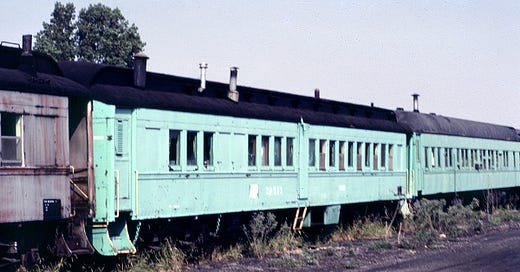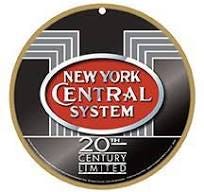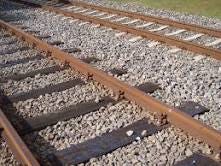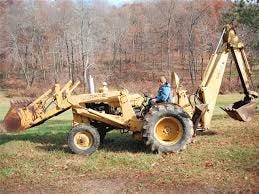The New York Central train ran from New York City to Chicago and our little village of 350 to 400 residents was on the line. It was exciting, as a grade schooler, to be near the tracks when the 20th Century Limited rushed through Wawaka. In the evening the dining car lights would expose waiters serving the passengers. My imagination went wild thinking about the beginnings and endings of their trips. Where were they coming from and where were they going? Why were the waiters black men and the diners white? Just wondering.
The freight trains were much slower and gave us lots of time for throwing stones at the sides of the freight cars. Those were the days before the elaborate graffiti shows now seen on freight trains. Each car had a number and I had read that there were people that could add those numbers up as the train passed. Savants with a an ‘island of genius’ I guess you could say. All I could do was rifle a rock off the side of the train.
Rails were put down as early as 1835 through Northern Indiana. Buying, selling, and consolidating of numerous lines eventually became the New York Central in 1914. Wawaka was a station stop before my time. I cannot imagine Wawaka without the NYC. It cut such a line through our existence. It caused grade schoolers to do dangerous things.
I enjoyed hearing a train coming down the track, east or west, and seeing it come into view. Now the game was to see how many times I could run back and forth over the double track before the train would get to the crossing. Calculations were important. You wanted to make it home for supper! The whistle was beginning to blow as the train approached the crossing. Could I get in one last run? A toe catching a rail could cause me a supper and more. Great sport when I wasn’t throwing stones against Billy Walton’s corrugated metal house right next to the tracks. My God, how they would ring, And then Billy’s mom would tear after us. I usually had a partner.
A version of the above Dashing Against the Train game was crawling under the tracks near the crossing. There were about 12 to 18 inches to shimmy under the rails. This was not nearly as dangerous. The train would just roar over you if you got caught and you could count on supper. One of the outcomes of this Rail Shimmy game was once being reported to the principle about this activity. He gave me a serious talking to — seemed like a bit out of his realm of authority. He was the same guy that paddled me for snowballing his kid off the school property. I think he had an authority issue. My dad got in on that one and chewed him out for paddling me.
Those were good days. As I sit over looking the The Virginia Creeper railroad bed, I wonder what kind of stuff I could have gotten into if I had been a young kid living in the Appalachians.
One of the most memorable railroad experience was when a number of work camp cars equipped for housing workers pulled off on a side track for several weeks. Railroad maintenance camps were a thing in those days. For a town the size of Wawaka this was a huge happening. It was like a little community moving right in on us. It is difficult to get clear information on those work camps at this time, but the workers were rough and tough. Prisoners were used for rail maintenance work. I don’t know if these guys were from prisons. They came from the west, from Chicago! Scary to little town folks. Of course they were supervised and stayed pretty much to themselves around the cars.
As I said, these guys were tough. I once went to Hooten’s Grocery to get a bottle of rubbing alcohol for my mom. They were out. The work camp guys used their allowances for the alcohol. There were no beer joints in Wawaka and the work camp was miles from a package liquor store. What else could you do: just guzzle some rubbing alcohol. Kids were told to stay away from the work camp, but it was pretty exciting for a town with nothing else going on.
A few years later my Dad got a contract with the NYC railroad to remove old railroad ties and replace them with new ties. The photo below will help to understand the work.
(If you are wondering how I did the Rail Shimmy game you will have to imagine that the crossing is built up with asphalt and the stone work stops a a few feet before the crossing. This allows grade-school-size boys to shimmy through the opening real close to the crossing.)
Anyway, I worked for Dad during my high school summers. He assigned me to one of his backhoes to assist railroad workers remove and replace ties. Dad took a 12” bucket and with an acetylene torch cut and rewelded the steel bucket, making it half the size. Now I could work the bucket to remove the stones from between the ties. I would pile them on the side of the track and later with a front end loader replace them over the new ties for the railroaders to smooth out.
This was a great summer job. An interesting part of it was that in an 8-hour day I might only be active in stone removal for 4 hours. Trains could still use the rails during this maintenance period. An alert would come from time to time and we would have to move off the track and wait. Serious waiting. Doing nothing for long periods of time. I had a transistor radio with me. I could listen to Elvis and Patsy Cline. I even took books with me. We were paid for 8 hours and worked about half of that.
Several years ago I watched repairs being made on a crossing nearby. I noted that the half-bucket needed for the tight work is now a standard bucket. Dad was on the cutting edge! Too bad he didn’t manufacture and market the Golden bucket. If he had been successful with that venture I might not have such a limited retirement budget. I could have been a trust fund baby and just sit back and dream of ways of dodging oncoming trains.








